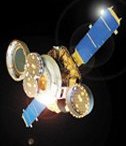Last month, a satellite closed its doors after more than 2 years of collecting ions from the relentless stream of particles that travels outward from the sun. Now, the craft must send the samples home.

Known as Genesis, the craft collected the ions on wafers made of ultrapure gold, silicon, sapphire, and diamond. “With data from this mission, we’ll be able to say what the sun is composed of at a level of precision . . . that has never been seen before,” says Genesis lead scientist Don Burnett of the California Institute of Technology in Pasadena.
Getting the solar booty into the hands of Burnett and his colleagues will require an extraordinary maneuver that pilots have already begun rehearsing. On Sept. 8, if all goes according to plan, the spacecraft will release its sample-return capsule, which will then parachute through Earth’s atmosphere. A helicopter will snatch the capsule in midair using custom-designed hooks. The solar material will be the first samples that NASA retrieved from space since the Apollo 17 astronauts carried moon rocks to Earth in 1972.







